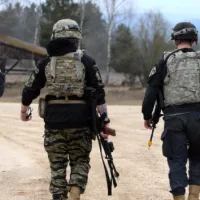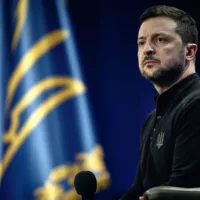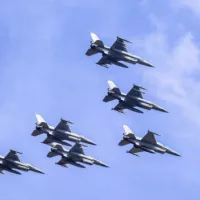
(WASHINGTON) — Nearly three years after Russia’s invasion of Ukraine, U.S. troops in Eastern Europe are using the lessons learned on the battlefields in Ukraine to modernize the Army’s tactics and use of new technologies or what the U.S. Army calls Transformation in Contact.
Soon after Russia invaded Ukraine in February 2022, thousands of U.S. military forces were sent to Eastern Europe to reassure NATO countries in the region and to deter Russia from expanding the conflict beyond Ukraine’s borders.
What started as a short-duration deployment has now grown to a current level of 23,000 U.S. Army troops maintained by a constant rotation of units on nine-month deployments.
“I have responsibility for (U.S. Army) forces from Estonia, U.S. forces that are stationed in Estonia all the way down to Bulgaria, 23 different foreign operating sites to assure our NATO partners and allies, but more importantly, to deter future Russian aggression.,” Lt. Gen. Charles Costanza, the commander of the U.S. Army’s Fifth Corps, told ABC News in an interview. “It’s just a critical time to be here right now.”
The deployment of those U.S. Army forces so close to Ukraine also means that they are able to apply what they are seeing on the country’s battlefields and how to apply it to their own operations.
“There’s not a better place to learn from the conflict in Ukraine than Eastern Europe,” said Costanza. “Our NATO partners are helping with training and equipping the Ukrainians. So we got a direct inject of all those lessons learned that are coming out of Ukraine.”
Those lessons learned include the revolutionary use of small commercially available drones to drop bombs on Russian targets, the development of long-range one-way attack drones, and techniques to evade electronic warfare detection that can be used to target forces on the frontlines by tracking radios and other communications gear.
“The speed of innovation on the SUAS and the counter-SUAS capability is incredible,” said Costanza, using the military acronym for Small Unmanned Aircraft Systems used to describe small drones.
“The Ukrainians will develop a new capability for those SUAS, the very next day, the Russians will figure out how to counter that which causes the Ukrainians to have to innovate and adapt very quickly and figure out something else,” he said.
In early February, U.S. Army forces trained for two weeks with other NATO countries in Germany in Combined Resolve, an exercise that is part of the Army’s Transformation in Combat, which uses some of the Army’s new gear and allows soldiers to innovate just like what is happening in Ukraine.
“When they’re in Combined Resolve fighting the opposing force, they’re going to figure out how to make stuff work and innovate while they’re in contact,” said Costanza. “I think the Transformation in Contact effort is just going to speed up how we equip our soldiers now quickly, and how we organize maybe a bit differently.”
For example, soldiers from the 2nd Cavalry Regiment, a unit permanently stationed in Germany, used 3-D printers to make sensors provided to soldiers that Costanza said could detect drones.
They also used a novel way of communicating by using commercially available technology provided to them to facilitate their radio communications with the Polish forces they were training with who did not speak English.
“To the point where you can pick up a radio and talk to somebody in a Polish unit, and it actually translates what you say into Polish so when it comes out on the Polish radio, the Polish soldier hears it, understands it, and to respond back, and you hear his response in English,” said Costanza.
He praised the ingenuity of young soldiers who “figure out how to make all this work, and bang, you have something that bridges a gap.”
Transformation in Contact is also changing how the Army arranges itself on the battlefield as the U.S. Army shifts away from the large field headquarters seen in Iraq and Afghanistan towards smaller dispersed units that can do the same thing.
The war in Ukraine has shown that large headquarters can be destroyed with missiles because the high levels of electronic signals they emit can be detected by electronic warfare tools.
“Now it’s individual vehicles that are spread out all over the battlefield, much from the electromagnetics spectrum standpoint, the signature is so much smaller, and it’s just harder to figure out what’s a command post and what might just be an individual vehicle,” said Costanza.
“They can actually work distributed like that to have that same common operational picture of what’s going on and to be able to synchronize everything they need to do to win the fight, but without physically being together,” he added.
Also used in the exercise was the Army’s new lightweight all-terrain vehicle, the Infantry Squad Vehicle which can transport as many as nine soldiers on the battlefield.
“You get nine guys on there and all their kit and you can quickly move now and reposition forces in a way that infantry brigades haven’t been able to do in the past. And so it just gives you a lot more capability,” said Costanza.
As the rotation of U.S. Army units in Eastern Europe continues, some of them will have already gone through previous versions of Transformation in Contact exercises carried out in the United States.
Costanza said those units will bring their lessons learned from those exercises and will also innovate with new concepts much as the units they are replacing have been doing during their deployment.
“So, we’re just going to keep learning as we keep fielding this stuff out, and just continuing to get better on how we organize ourselves and how we equip ourselves,” said Costanza.
Copyright © 2025, ABC Audio. All rights reserved.















